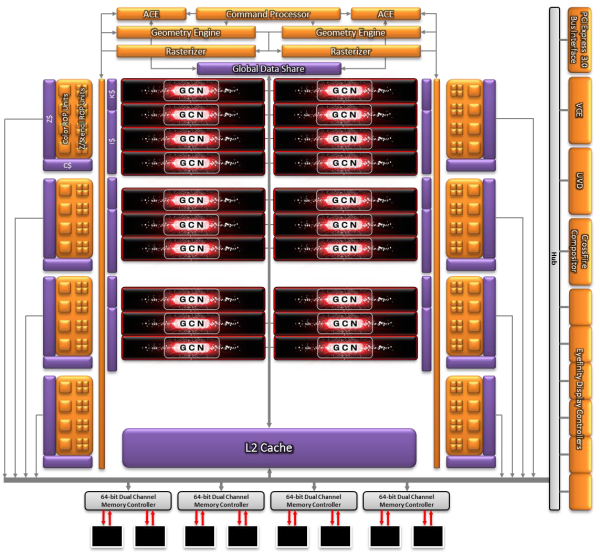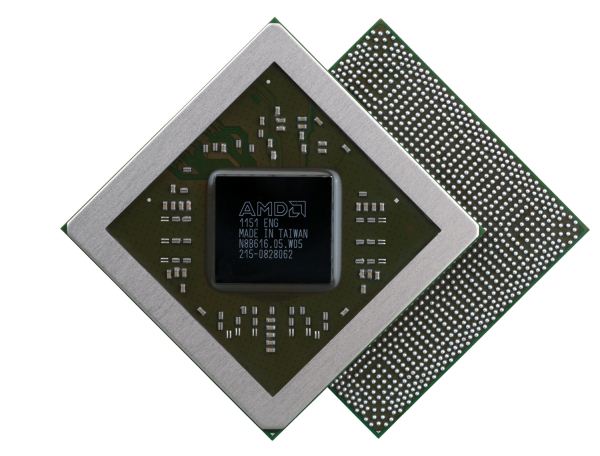AMD Radeon HD 7870 GHz Edition & Radeon HD 7850 Review: Rounding Out Southern Islands
by Ryan Smith on March 5, 2012 12:01 AM ESTIn 2009-2010, AMD launched the entire 4 chip Evergreen series in 6 months. By previous standards this was a quick pace for a new design, especially since AMD had not previously attempted a 4 chip launch in such a manner. Now in 2012 AMD’s Southern Islands team is hard at work at wrapping up their own launch with new aspirations on quickness. Evergreen may have launched 4 chips in 6 months, but this month AMD will be completing the 3 chip Southern Islands launch in half the time – 3 chips in a mere 3 months.
To that end today AMD is taking the wraps off the final piece of the Southern Islands puzzle: Pitcairn. The middle child of the family, it will be the basis of AMD’s $250+ enthusiast segment Radeon HD 7800 series. We’ve seen AMD capture the high-end with the 7900 series and struggle to control the mainstream market with the 7700 series, but how does the 7800 series fare amidst AMD’s lead in deploying 28nm GPUs? Let’s find out.
| AMD GPU Specification Comparison | |||||||
| AMD Radeon HD 7870 | AMD Radeon HD 7850 | AMD Radeon HD 6970 | AMD Radeon HD 6950 | AMD Radeon HD 5870 | |||
| Stream Processors | 1280 | 1024 | 1536 | 1408 | 1600 | ||
| Texture Units | 80 | 64 | 96 | 88 | 80 | ||
| ROPs | 32 | 32 | 32 | 32 | 32 | ||
| Core Clock | 1000MHz | 860MHz | 880MHz | 800MHz | 850MHz | ||
| Memory Clock | 4.8GHz GDDR5 | 4.8GHz GDDR5 | 5.5GHz GDDR5 | 5.0GHz GDDR5 | 4.8GHz GDDR5 | ||
| Memory Bus Width | 256-bit | 256-bit | 256-bit | 256-bit | 256-bit | ||
| Frame Buffer | 2GB | 2GB | 2GB | 2GB | 1GB | ||
| FP64 | 1/16 | 1/16 | 1/4 | 1/4 | 1/5 | ||
| Transistor Count | 2.8B | 2.8B | 2.64B | 2.64B | 2.15B | ||
| PowerTune Limit | 190W | 150W | 250W | 200W | N/A | ||
| Manufacturing Process | TSMC 28nm | TSMC 28nm | TSMC 40nm | TSMC 40nm | TSMC 40nm | ||
| Architecture | GCN | GCN | VLIW4 | VLIW4 | VLIW5 | ||
| Price Point | $350 | $250 | N/A | N/A | N/A | ||
So what exactly is Pitcairn? In a nutshell, take Cape Verde (7700) and double it, and you have Pitcairn. Pitcairn has twice the number of CUs, twice the number of ROPs, twice the memory bandwidth, and of particular importance twice as many geometry engines on the frontend. This works out to 1280 SPs among 20 CUs – organized as a doubling Cape Verde’s interesting 4/3/3 configuration – 80 texture units, 32 ROPs, 512KB L2 cache, and a 256-bit memory bus. Compared to Tahiti, Pitcairn still has 12 fewer CUs and as a result less shader and texturing performance along with the narrower memory bus, but it has the same number of ROPs and the same frontend as its bigger brother, which as we’ll see creates some very interesting situations.
On the functionality side of things, the Cape Verde comparisons continue. As with all Southern Islands family parts, Pitcairn supports things such as DX10+ SSAA, PowerTune, Fast HDMI support, partially resident textures, D3D 11.1 support, and the still-AWOL Video Codec Engine (VCE). FP64 support is once again present, and like Cape Verde it’s a performance-limited implementation for compatibility and software development purposes, with FP64 performance limited to 1/16th FP32 performance.
AMD’s Pitcairn cards will be the Radeon HD 7870 GHz Edition and the Radeon HD 7850. The 7870 is a full Pitcairn, clocked at 1000MHz core and paired with 2GB of GDDR5 running at 4.8GHz. It has a PowerTune limit of 190W while AMD puts its typical board power draw closer to 175, meanwhile idle power consumption is around 10W with a long idle of 3W like the rest of Southern Islands. As for the 7850 it’s the typical lower tier part, featuring 16 active CUs (1024 SPs), an 860MHz core clock, and the same 2GB of GDDR5 running at 4.8GHz as its counterpart, giving it roughly 68% the shading/texturing performance and 86% of the ROP & frontend performance of the 7870. The PowerTune limit is 150W with a typical board power of 130W, and the same 10W/3W idle power consumption as the 7870.
Altogether the 7800 series isn’t just the successor to the Barts based 6800 series in name but also the successor to the 6800 in design. This includes not only power consumption, with one card being a sub-150W part, but also with regards to things such as CrossFire, where it features a single CF connector. Interestingly enough even though Barts was already a fairly small chip for its performance, Pitcairn takes this one step further with a die size of 212mm2, which in turn contains 2.8B transistors, only 160M more than Cayman. As we’ll see when we get to our benchmarks, this makes Pitcairn a surprisingly small chip given its 6970+ performance.
Speaking of the 6970, let’s talk about the 7800 series’ competition. As AMD began winding down Cayman (6900 series) almost immediately with the launch of the 7900 series, at this point the 6900 market has effectively dried up. Having taken themselves out of competition with themselves, AMD’s only competition is NVIDIA’s lineup. From a performance and price basis the 7870 and 7850 don’t map particularly well to any specific NVIDIA products, but generally speaking they’re targeted against the GTX 570 and GTX 560 Ti respectively.
With AMD targeting the ~$320 570 and ~$210 560 Ti and given their conservative pricing on the rest of Southern Islands, it should come as no surprise that the 7800 series is priced equally conservatively. The 7870 will have an MSRP of $350, while the 7850 will have an MSRP of $250. With the 7800 series completing the launch of Southern Islands, this gives AMD a consistent price structure for the entire family: $550, $450, $350, $250, $159, and $109.
Finally, as far as availability goes this will be a delayed launch. AMD is formally unveiling the 7800 series today, but it will not go on sale until the 19th, 2 weeks from now. AMD has said that this is due to both CeBIT and the Game Developers Conference; AMD and their partners want to be able to show off the 7800 series to their respective attendees at those events, with both events being far too large to keep the 7800 under wraps. This delayed launch also means that partner cards aren’t quite ready yet, so we only have AMD’s reference cards on hand. We’ll be taking a look at partner cards later this month.
| Spring 2012 GPU Pricing Comparison | |||||
| AMD | Price | NVIDIA | |||
| Radeon HD 7950 | $450 | GeForce GTX 580 | |||
| Radeon HD 7870 | $350 | ||||
| $330 | GeForce GTX 570 | ||||
| Radeon HD 7850 | $250 | ||||
| $200 | GeForce GTX 560 Ti | ||||
| $179 | GeForce GTX 560 | ||||
| Radeon HD 7770 | $159 | ||||













173 Comments
View All Comments
Beenthere - Tuesday, March 6, 2012 - link
Yes at the moment AMD is most definitely getting top dollar for these Vid cards just as Intel does all of the time on their CPUs - until they have competition.In case you didn't notice the new 7xxx series cards surpass Nvidia's current offerings in just about every category so this IS a step forward in performance at the same or lower prices.
MMoudry - Tuesday, March 6, 2012 - link
Hello,Does anybody know if those two cards would work in crossfire? The Crossfire compatibility chat is not yet up to date and I can't seem to find that information anywhere....
Sources:
http://sites.amd.com/us/game/technology/Pages/cros...
MM
Hrel - Tuesday, March 6, 2012 - link
Hd6870 and gtx 560 can be had for 160 and 165 respectively. WHY would anyone want the SIGNIFICANTLY slower 7770? It's not like it's directX 12 or something.Alpert - Tuesday, March 6, 2012 - link
I can understand why so many get it wrong but I can also clearly see.7770 currently retails for $169.99 - $179.99
6870's currently retail for $189.99 - $209.99 original price was $249.99
I just checked these numbers from 3 retailer
7770 is a weaker card then the 6870, sure but performance per dollar is actually a little better with the 7770. Considering the lack of competition from Nvidia why would AMD reduce the price to performance ratio that exists. AMD is selling you more features for a better value card.
When Kepler arrives AMD price's could go down if Nvidia prices it that way. If Kepler is all the #$%^ it's hyped to be AMD will counter it with a price drop then we all win. Looking at ATI/AMD's history something they have always offered the customer, superior price/performance of the competition.
AMD will always be better price to performance for less while Nvidia justifies there inflated prices with CUDA, PhysX, TWIMTBP and of course better driver support.
The value of performance will remain as is. Like a commodity on the stock exchange, why would Nvidia devalue there own stock or at least so quickly?
Hrel - Wednesday, March 7, 2012 - link
I checked the prices I listed on newegg just before posting that. Not sure where you got your prices from, but shop newegg in the future... that way you aren't wrong :p.bozolino - Tuesday, March 6, 2012 - link
There is something REALLY odd about 560 TI numbers on ELDERS SCROLL V.Under 7770 REVIEW it shows 7770 right above 550 TI and on the top of all them is a standard GTX 560 with like 46 fps and here, on this review it shows the GTX 560 TI with like 36 fps. The settings look just like the same..
Please correct that because it is looking like the GTX 560 TI is worse than the 7770, wich it isnt by at least a mile.
Alpert - Tuesday, March 6, 2012 - link
With a 7770 the power consumption is below that of the Radeon HD 6870 and GeForce GTX 560 Ti, while still delivering the same gameplay experience of those video cards. About 2%-7% slower then 560 Ti.CeriseCogburn - Thursday, March 8, 2012 - link
This isn't HardOCP Alpert.slypher1024 - Wednesday, March 7, 2012 - link
My 5850 still server me well @ 1600x900 res.. Not until these prices drop i'll upgrade..AMD is obviously maximizing profit with these products, seeing that Nvidia next launch is at least 2 months away...
SAD
gammaray - Wednesday, March 7, 2012 - link
Price wars, really?seriously, 250$ for a low end video card and 350$ for a mid range video card, not even the MAIN LINE serie but somewhat weaker versions of their 7900 serie counterpart.
Video card markets have been ripping off consumers in the past years with their super hefty high prices.
it should be like that: 150$ for new low end video cards, 250$ for new mid-range and 350$+ for whatever they want to sell to whoever will always buy the most expensive stuff no matter.
the price of the 6800 should all be below 100$ right now and the 6900 serie prices cut in half .